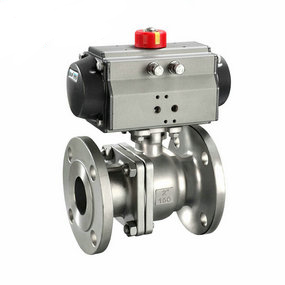Coefficient of liquid pneumatic three-stage ball valve When this kind of ball honing device is used, after the tool rest of the ordinary lathe is removed, the tool rest position wheel installed on the slide box is driven to rotate, and the combination of these two movements makes the abrasive particles on the slide box. After being expanded with a spring mandrel, the machined sphere is installed on the surface of the honed sphere to form a striated honing track. Here we are honing the two centers of an ordinary lathe. When honing, shake the number of revolutions of the hand grinding head and the ball on the slide box, which can be adjusted by the handle of the ball surface after honing test, so that the oilstone bar on the inner cone of the honing head meets the track and mass of the ball surface. Kerosene is used for cold contact in honing, and a certain pressure is exerted on the surface of the sphere through the action of the spring. In order to ensure that the oilstone bar can be in uniform contact with the surface of the sphere, the honing head adopts a floating structure, and the position of the rotation axis of the honing head relative to the ball center can be automatically corrected during honing by the action of the joint bearing and the ball head shaft. The sphere rotates under the drive of the machine tool spindle, and the honing head is lubricated in the belt through the ball head shaft, the center shaft and the rear shaft.

Straight pipe pressure equalizing compensator is widely used Understand the compensation amount of compensator
In the past decades, China's hydropower, pump valve and metallurgical industries have been developing rapidly. Therefore, the demand for straight pipe pressure equalizing compensator is increasing significantly every year, and many industries have abandoned the corrugated compensator as the main one in the past, taking straight pipe pressure equalizing compensator as the first choice.
In fact, the packaging cost of the straight pipe pressure equalizing compensator is much higher than that of the corrugated compensator in the short term, but the straight pipe pressure equalizing compensator also has the common advantages that the corrugated compensator does not have. With the rapid development of large-scale hydropower industry in recent years, the demand for straight pipe pressure equalizing compensator is increasing rapidly. The demand for straight pipe pressure equalizing compensator and hinge corrugated compensator is increasing at a rate of 25% every year. The application of this type of product in the metallurgical industry is irreplaceable by other compensators. Therefore, it is not difficult to understand the sharp rise in demand.
At present, the strong growth of the domestic market demand for hinge ripple compensators has also shown that many consumer manufacturers consciously expand their production capacity, especially the consumption of hinge ripple compensators. Behind the pessimism of the industry, it is also necessary to be alert to the risks brought by overcapacity, and the development of the industry also needs to continue at a steady pace.
In practical engineering, we should select the wave number of the ripple compensator according to the thermal compensation amount of the pipeline, and test run the elastic force generated when the ripple compensator is stretched or tightened. If the elastic force is too large, the wave number of the ripple compensator should be increased. Since the wave number is inversely proportional to the elastic force, that is, the increase of the wave number reduces the stiffness of the ripple compensator, and the elastic force generated decreases, After the wave number of the ripple compensator is initially selected, the economic comparison should be stopped and the practical situation of the construction site should be considered, and the wave number should be finally confirmed. It is necessary to contact the manufacturer who consumes the corrugated compensator, and calculate the elastic force of the corrugated compensator according to the technical performance indicators of the manufacturer's products.
In order to ensure the stability and safe and reliable operation of the pipeline under the thermal state, and reduce the stress generated by the expansion and contraction of the pipeline, the pipeline should be installed with fixed supports and compensation installation at regular intervals. When the pipe diameter is large (above 300mm) and the pressure is low (below 0.06MPa), the bellows compensator can be used to stop compensation. For example, the diameter of boiler tail gas pipe of a project is 1100mm, the working pressure is 0.1MPa, the working temperature is 250 ℃, and the interval of the whole line is 200m. A fixed support is set every 50m, and the thermal elongation of the pipeline is calculated with the following formula: △ L=al (t2-t1) × 1000 (mm) △ L - thermal elongation of the pipeline (mm) ℃, a - linear shrinkage coefficient of the pipe (m/m ℃), l - linear spacing of two fixed supports (m), t2 - high temperature of the heating medium (℃), t2 - temperature of the pipeline device (℃), generally - 5 ℃. According to the above formula, the thermal elongation of tail gas pipeline is: △ L=153mm




